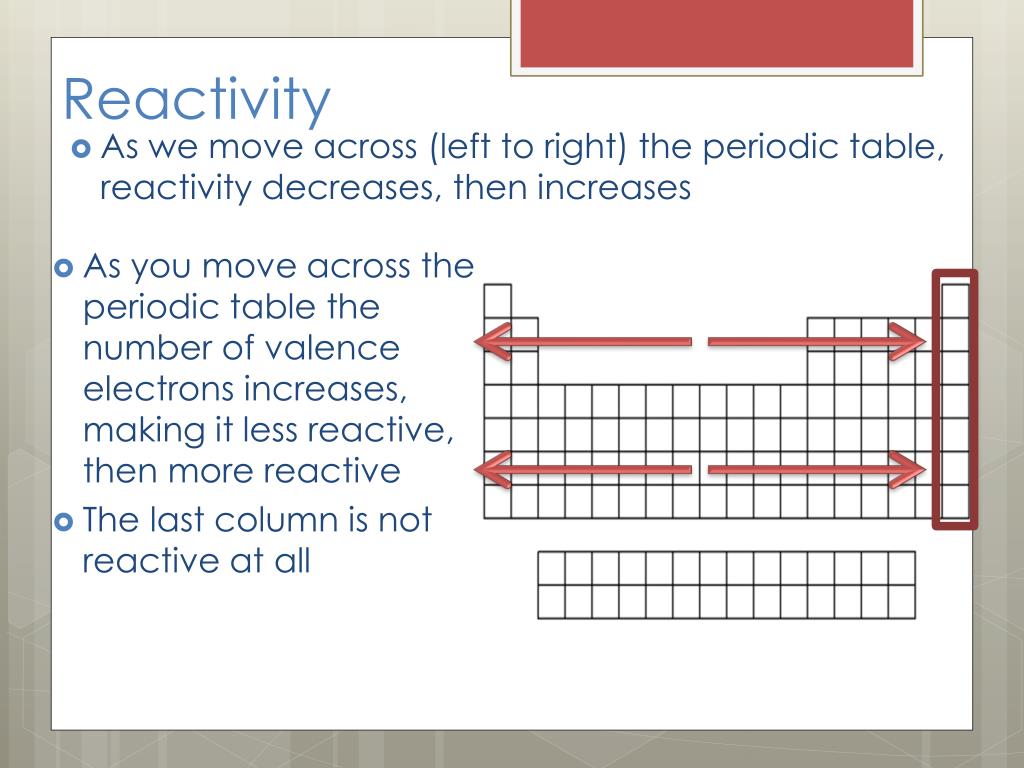
Reactivity chart chemistry series#
The reactivity series of metals is a chart listing metals in order of. Protons belong to the family of particles known as hadrons. Further chemical reactions, rates and equilibrium, calculations and organic. A chart of the reactivity series of common metals is provided below.

It can also be used to obtain information on the reactivity of metals towards water and acids. Proton A subatomic particle that is one of the basic building blocks of the atoms that make up matter. The data provided by the reactivity series can be used to predict whether a metal can displace another in a single displacement reaction. Neutrons belong to the family of particles known as hadrons. Neutron A subatomic particle carrying no electric charge that is one of the basic pieces of matter. Each Chart is laminated with 27 micron thick polyester film rendering the. Examples include hydrogen, oxygen, carbon, lithium and uranium. This chart explains various concepts related to chemistry through illustrations. Chemical also can be an adjective to describe properties of materials that are the result of various reactions between different compounds.Įlectron A negatively charged particle, usually found orbiting the outer regions of an atom also, the carrier of electricity within solids.Įlement (in chemistry) Each of more than one hundred substances for which the smallest unit of each is a single atom. For example, water is a chemical made when two hydrogen atoms bond to one oxygen atom. The nucleus is orbited by a cloud of negatively charged electrons.Ītomic Having to do with atoms, the smallest possible unit that makes up a chemical element.Ītomic number The number of protons in an atomic nucleus, which determines the type of atom and how it behaves.Īverage (in science) A term for the arithmetic mean, which is the sum of a group of numbers that is then divided by the size of the group.Ĭhemical A substance formed from two or more atoms that unite (bond) in a fixed proportion and structure. Atoms are made up of a dense nucleus that contains positively charged protons and uncharged neutrons. 2.29 understand that metals can be arranged in a reactivity series based on the reactions of the metals and their compounds: potassium, sodium, lithium.
Reactivity chart chemistry full#
The year 2019 marks the 150th anniversary of the periodic table, first conceived in 1869.Ĭheck out the full list of Scientists Say.Ītom The basic unit of a chemical element. That brought the number of known elements to 118 and completed the 7th row of the table. ChemTube3D contains interactive 3D chemistry animations and structures, with supporting information, for students studying some of the most. Starting in the 1940s, scientists found many new elements by colliding atoms or pieces of atoms.Īt the end of 2018, chemists confirmed four elements that had never been observed before. This is a group of elements such as helium that don’t like to react with other elements. These include the noble gases, identified in 1890. The periodic table continued to grow as scientists discovered more elements.

Other scientists were working on their own periodic tables, but Mendeleev published his table first. He saw trends in the elements’ properties that varied over specific intervals, or periods. In 1869, the Russian chemist Dimitri Mendeleev lined up the 63 known elements in order by their atomic weights. An atomic weight is the average weight of one atom of an element. But they did understand that elements had different atomic weights. Back then, scientists didn’t know about the protons, neutrons and electrons that make up atoms.

It also shows how its electrons are arranged.ĭuring the mid-1800s, many chemists looked for patterns that explained how elements interacted. 1) is to show chemical combinations known or believed to be dangerously reactive in the case of unintentional mixing, to indicate whether bulk chemicals can be shipped in adjacent cargo tanker holds. An element’s place also shows how likely it is to react. The purpose of the Compatibility Chart’ (Figure E. The reactivity series of metals is a list of metals arranged in their order of reactivity from highest to lowest. Those on top of the chart have the fewest protons. First, the elements are organized by atomic number, or how many protons they have.

A common misconception held about chemical reactions is that reactants. The location of each square in the table tells many things about each element. Printable results tables are provided in this booklet to save time in your. A square contains one or two letters that stand for the element’s name, and numbers that tell about that element’s properties. The table is made up of over a hundred squares. This is a chart that shows all the known chemical elements. \): Elements categorized into metals, non-metals and metalloids.Periodic table (noun, “peer-ee-AHH-dik TAY-bul”)


 0 kommentar(er)
0 kommentar(er)
